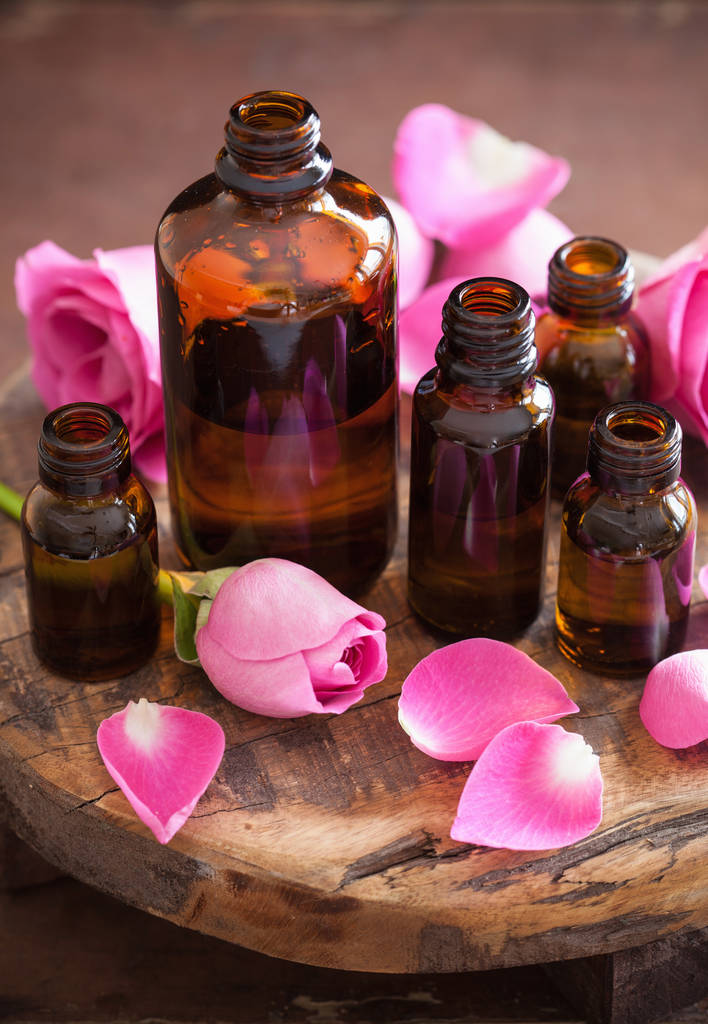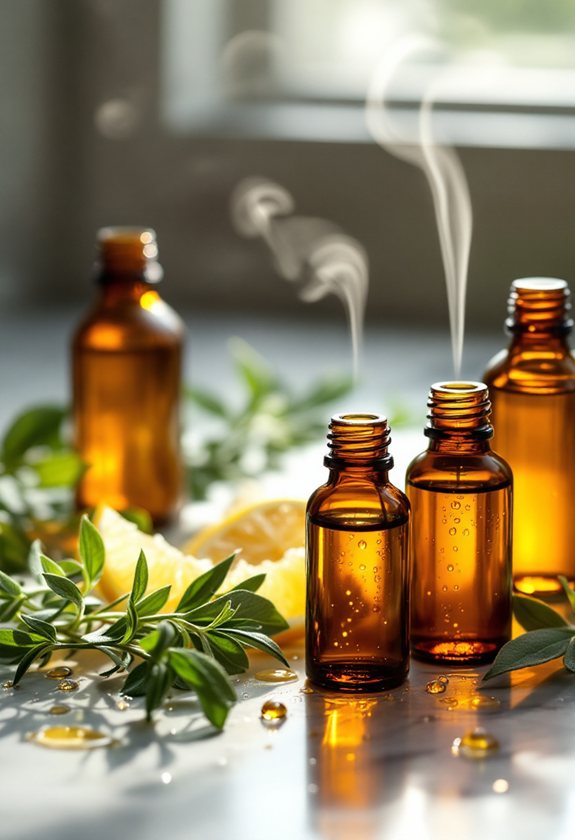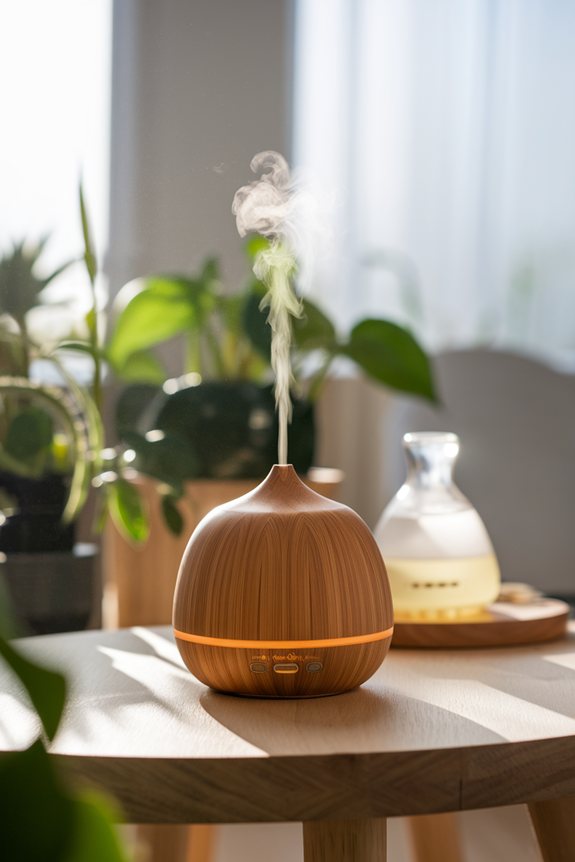To deep clean your aromatherapy tools naturally, start by adding one tablespoon white vinegar and half a cup distilled water to your diffuser, let it sit for 10 minutes, then wipe with a lint-free cloth. For stubborn residue, use a baking soda paste with a few drops of crucial oil and gently scrub. Wash fragile parts with mild, unscented soap and rinse thoroughly. Always air dry away from sunlight and store in a cool, dry place. For more expert details, continue below.
Key Takeaways
- Clean diffusers using a mixture of white vinegar and distilled water, letting it sit before wiping down all surfaces.
- Use a steam cleaner for chemical-free, deep cleaning of aromatherapy tools, adding essential oils for enhanced purification.
- Create a gentle baking soda paste with essential oils to scrub away stubborn residue and neutralize odors naturally.
- Wash tools with mild, unscented, pH-balanced soap and rinse with filtered or distilled water for gentle, effective cleaning.
- Allow all components to air dry completely on a lint-free towel before storing them in a cool, dry place away from sunlight.
Essential Oil Solutions for Diffuser Cleaning
Keeping your diffuser clean is vital if you want pure, effective aromatherapy sessions every time.
Regular natural cleaning preserves the integrity of your fundamental oils and protects those you serve.
Start by unplugging your diffuser. Experts recommend using white vinegar as a natural cleaning agent—simply add a tablespoon to half a cup of distilled water in the tank.
Swirl gently and let sit for 10 minutes.
Use a cotton swab dipped in vinegar to carefully clean the ultrasonic plate, then a soft brush for any residue in the tank.
Wipe down with a damp paper towel to prevent corrosion, and finish with a lint-free cloth.
“Consistent maintenance guarantees clarity of scent and ideal diffusion,” says aromatherapy consultant Jane Lee.
Clean weekly for best results.
Steam Cleaning Techniques for Mindful Maintenance
Although natural cleaning agents work well, steam cleaning offers a powerful, chemical-free way to deep clean your aromatherapy tools. When you use high steam pressure, you’ll penetrate stubborn oils and residues, sanitizing surfaces without harsh chemicals.
Preheat your steam cleaner thoroughly—sufficient heat is key for killing bacteria, fungi, and viruses. To enhance results, add a few drops of crucial oil, like tea tree or eucalyptus, to the water tank. This combines aromatherapy with cleaning, but don’t overdo it to avoid clogging the device.
Clean sensitive materials, such as wood, with minimal moisture, and always allow tools to air dry completely. Experts recommend, “Adjust cleaning frequency to your usage—steam clean after every few uses for lasting hygiene and performance.”
Baking Soda Methods to Remove Stubborn Residue
Even with regular rinsing, stubborn residue from important oils, wax, and mineral deposits can cling to your aromatherapy tools. Baking soda benefits you by offering gentle abrasiveness and an alkaline pH, breaking down tough buildup without harming delicate surfaces. For effective residue removal, combine 1/3 cup baking soda with 15 drops of peppermint, lemon, or lavender oil—this blend enhances antimicrobial action and neutralizes odors.
Here’s a quick-reference table for your cleaning routine:
| Method/Ingredient | Purpose/Benefit |
|---|---|
| Baking soda paste | Loosens and scrubs residue |
| Vinegar combo | Effervescent reaction lifts deposits |
| Vital oils | Antimicrobial, fresh scent |
| Glass jar storage | Maintains freshness, prevents moisture |
| Microfiber cloth | Precise application on tricky surfaces |
Mild Soap and Water Rinses for Gentle Care
When you want a gentle yet effective way to clean aromatherapy tools, mild soap and water rinses are your best choice. Mild soap effectiveness depends on using natural, unscented, and sulfate-free formulas—these prevent residue buildup and protect your tools from chemical wear.
Stick with pH-balanced soaps (5.5–7) to avoid corrosion, especially on metal or porous surfaces.
Follow water temperature guidelines carefully: keep water below 140°F (60°C) to prevent warping plastics and melting adhesives. For metal tools, use cold water to avoid oxidation; for glass and ceramics, rinse twice with filtered or distilled water for streak-free results.
As cleaning expert Jamie Lee notes, “A diluted, gentle soap and proper temperature protect both your tools and the crucial oils you use to serve others.”
Safe Air Drying and Storage Practices
Since proper drying and storage are just as crucial as cleaning, you’ll want to follow best practices to keep your aromatherapy tools safe and effective.
Begin by practicing safe drying: place cleaned components on a clean, lint-free towel or raised rack in a well-ventilated area—never in direct sunlight. Make sure every part is completely dry before assembling or storing to prevent mold or bacterial growth.
For proper storage, keep tools in a cool, dry place away from sunlight and humidity. Use airtight containers for small items like droppers, and store glass upright to avoid damage.
“Separate tools by type and frequency of use to limit contamination,” recommends expert aromatherapist Karen Li.
Regularly inspect and clean storage areas to maintain pristine conditions for your clients’ well-being.
Preventing Clogs and Odors Naturally
Although regular cleaning keeps your aromatherapy tools in good shape, preventing clogs and odors requires targeted steps and natural ingredients.
For effective preventive cleaning, start by emptying and rinsing reservoirs after each use. “A quick rinse with distilled water goes a long way in stopping buildup,” advises holistic wellness expert Dr. Lee Tran.
Use white vinegar to dissolve mineral deposits, and baking soda as a gentle abrasive to neutralize odors. Add a few drops of tea tree or eucalyptus oil for antimicrobial action.
For tough residues, scrub with a baking soda paste mixed with lemon oil.
Store your crucial oils in glass containers, and always let your tools air dry fully before storage.
These natural ingredients and methods will help you serve others with fresh, clog-free aromatherapy experiences.
Conclusion
By following these natural cleaning methods, you’ll keep your aromatherapy tools in top condition. Use crucial oil solutions for regular maintenance, and try steam cleaning or baking soda for tougher residue. Mild soap and water work well for gentle care. As expert aromatherapist Dr. Lisa Turner recommends, “Consistent cleaning preserves tool performance and aroma quality.” Always air dry thoroughly and store properly. With these steps, you’ll prevent clogs, odors, and keep your sessions effective.



